Analyzing Cybercrime: Government Sponsorship vs. Public Negligence
VerifiedAdded on 2023/06/07
|13
|3316
|262
Essay
AI Summary
This essay discusses the escalating issue of cybercrime in our globally connected world, focusing on whether government sponsorship or public negligence is the primary driver. It defines cybercrime, outlines various methods of committing it, and highlights its threats to national security. The essay delves into instances of state-sponsored cyber-attacks by countries like Russia and China, while also acknowledging efforts by government-funded organizations to combat cybercrime through legal frameworks, security policies, and international collaborations. It references initiatives by the U.S., Europe, and the UN to counter cyber threats, emphasizing the importance of risk assessment, advanced analytics, and international cooperation. The essay concludes by suggesting that while government entities may be involved in certain cyber activities, significant measures are also being taken to prevent and mitigate cybercrimes worldwide. Desklib provides this essay and many other resources for students.
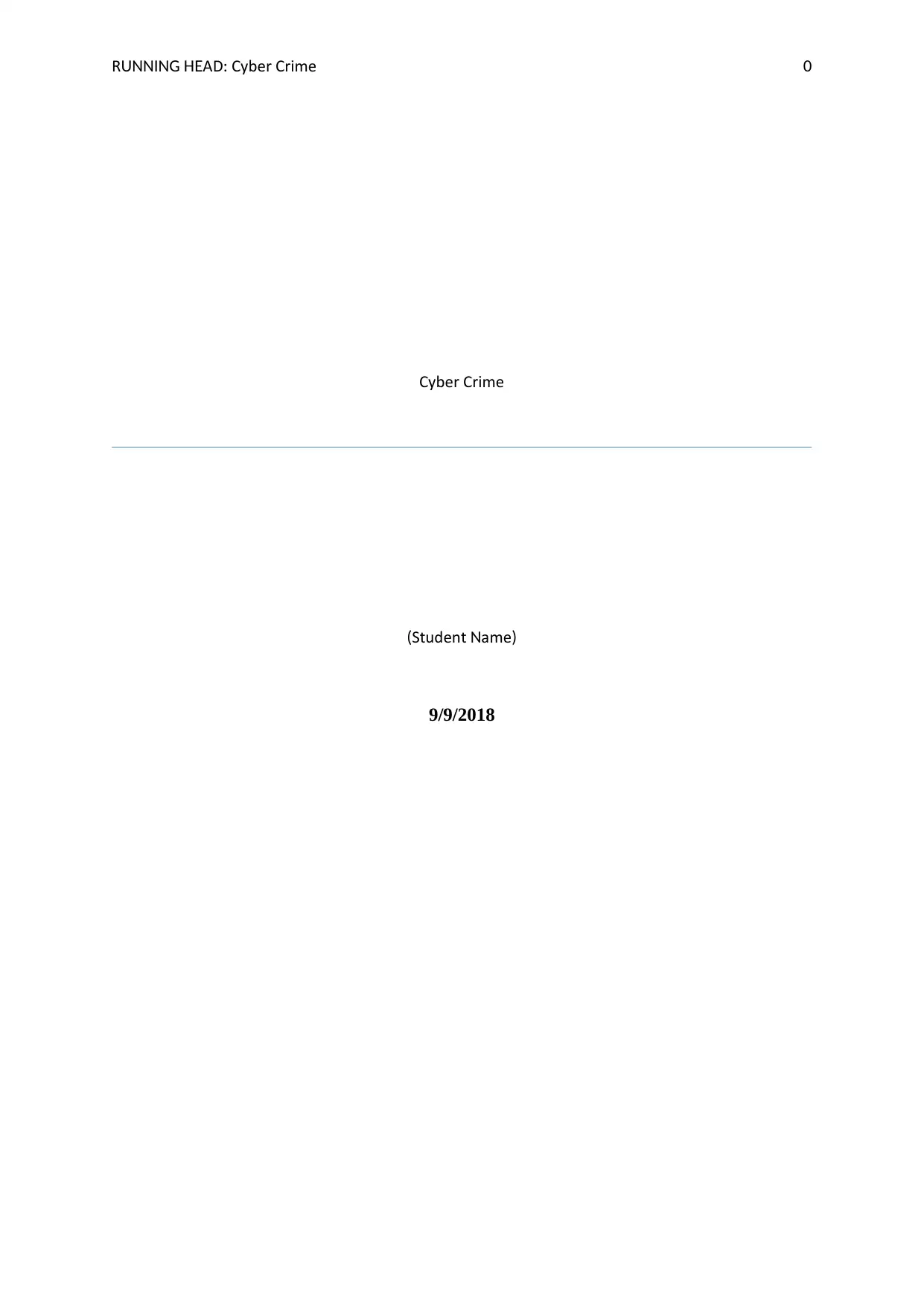
R AD Cyber CrimeUNNING HE : 0
Cyber Crime
Student ame( N )
9/9/2018
Cyber Crime
Student ame( N )
9/9/2018
Paraphrase This Document
Need a fresh take? Get an instant paraphrase of this document with our AI Paraphraser
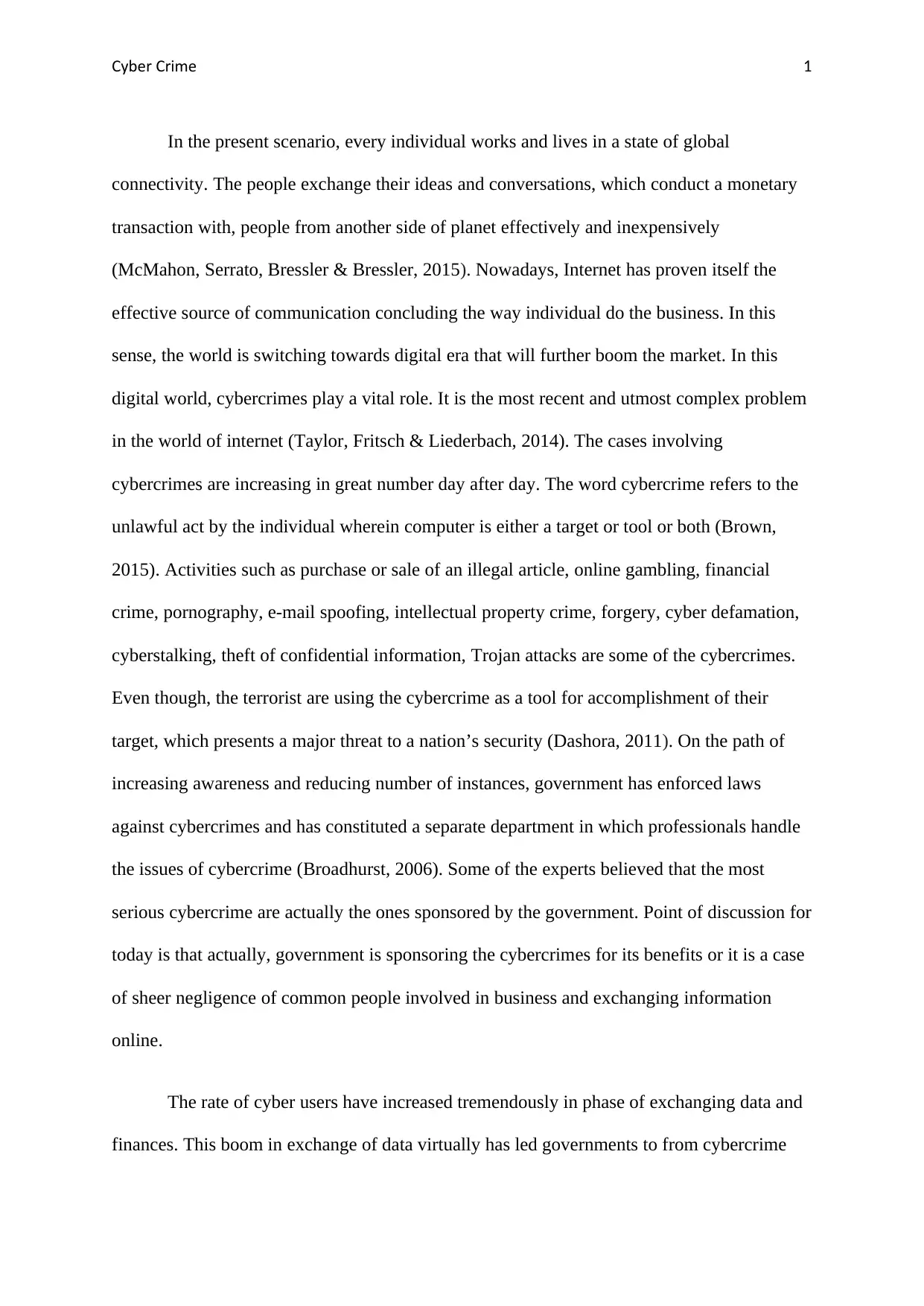
Cyber Crime 1
In the present scenario, every individual works and lives in a state of global
connectivity. The people exchange their ideas and conversations, which conduct a monetary
transaction with, people from another side of planet effectively and inexpensively
(McMahon, Serrato, Bressler & Bressler, 2015). Nowadays, Internet has proven itself the
effective source of communication concluding the way individual do the business. In this
sense, the world is switching towards digital era that will further boom the market. In this
digital world, cybercrimes play a vital role. It is the most recent and utmost complex problem
in the world of internet (Taylor, Fritsch & Liederbach, 2014). The cases involving
cybercrimes are increasing in great number day after day. The word cybercrime refers to the
unlawful act by the individual wherein computer is either a target or tool or both (Brown,
2015). Activities such as purchase or sale of an illegal article, online gambling, financial
crime, pornography, e-mail spoofing, intellectual property crime, forgery, cyber defamation,
cyberstalking, theft of confidential information, Trojan attacks are some of the cybercrimes.
Even though, the terrorist are using the cybercrime as a tool for accomplishment of their
target, which presents a major threat to a nation’s security (Dashora, 2011). On the path of
increasing awareness and reducing number of instances, government has enforced laws
against cybercrimes and has constituted a separate department in which professionals handle
the issues of cybercrime (Broadhurst, 2006). Some of the experts believed that the most
serious cybercrime are actually the ones sponsored by the government. Point of discussion for
today is that actually, government is sponsoring the cybercrimes for its benefits or it is a case
of sheer negligence of common people involved in business and exchanging information
online.
The rate of cyber users have increased tremendously in phase of exchanging data and
finances. This boom in exchange of data virtually has led governments to from cybercrime
In the present scenario, every individual works and lives in a state of global
connectivity. The people exchange their ideas and conversations, which conduct a monetary
transaction with, people from another side of planet effectively and inexpensively
(McMahon, Serrato, Bressler & Bressler, 2015). Nowadays, Internet has proven itself the
effective source of communication concluding the way individual do the business. In this
sense, the world is switching towards digital era that will further boom the market. In this
digital world, cybercrimes play a vital role. It is the most recent and utmost complex problem
in the world of internet (Taylor, Fritsch & Liederbach, 2014). The cases involving
cybercrimes are increasing in great number day after day. The word cybercrime refers to the
unlawful act by the individual wherein computer is either a target or tool or both (Brown,
2015). Activities such as purchase or sale of an illegal article, online gambling, financial
crime, pornography, e-mail spoofing, intellectual property crime, forgery, cyber defamation,
cyberstalking, theft of confidential information, Trojan attacks are some of the cybercrimes.
Even though, the terrorist are using the cybercrime as a tool for accomplishment of their
target, which presents a major threat to a nation’s security (Dashora, 2011). On the path of
increasing awareness and reducing number of instances, government has enforced laws
against cybercrimes and has constituted a separate department in which professionals handle
the issues of cybercrime (Broadhurst, 2006). Some of the experts believed that the most
serious cybercrime are actually the ones sponsored by the government. Point of discussion for
today is that actually, government is sponsoring the cybercrimes for its benefits or it is a case
of sheer negligence of common people involved in business and exchanging information
online.
The rate of cyber users have increased tremendously in phase of exchanging data and
finances. This boom in exchange of data virtually has led governments to from cybercrime
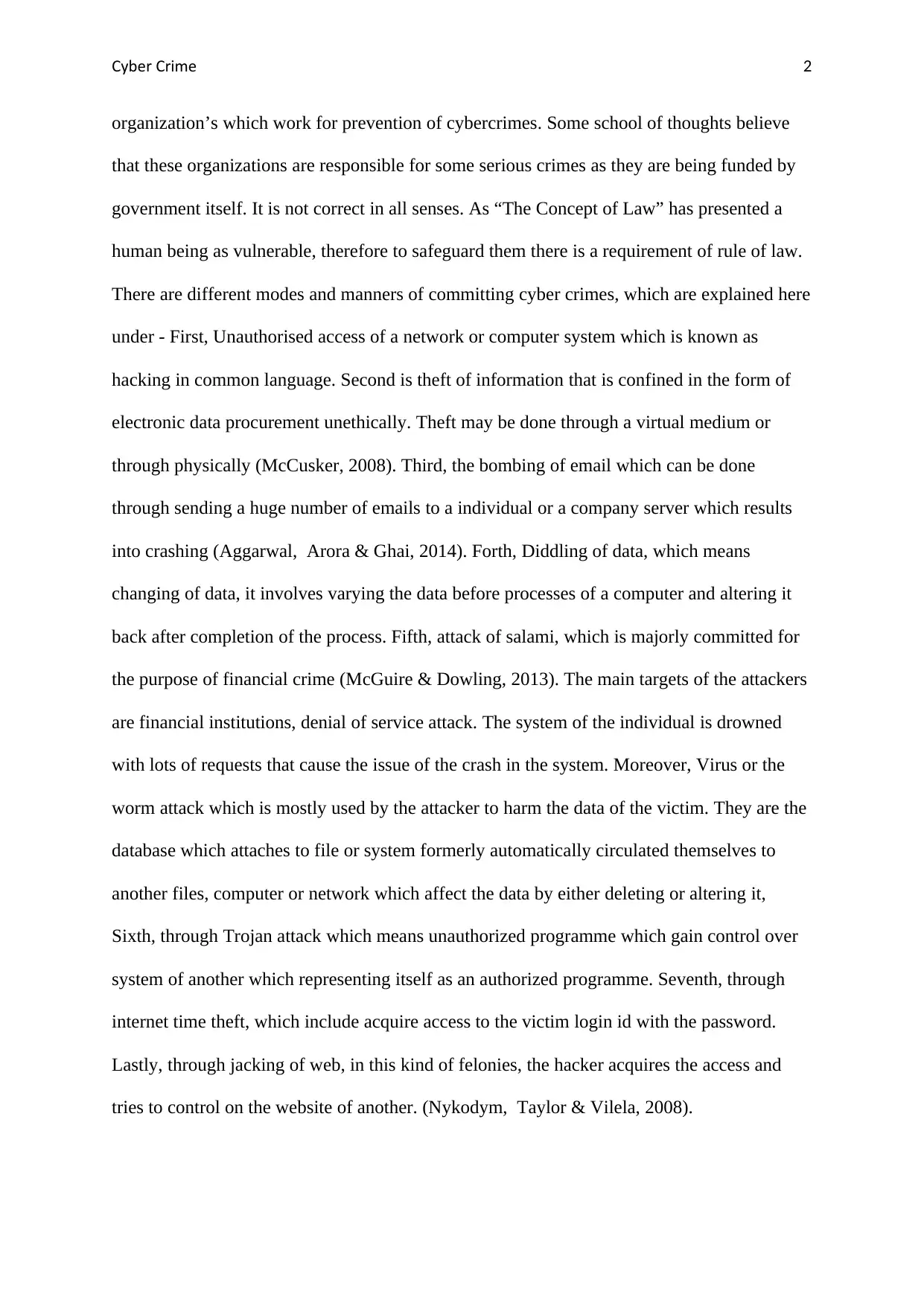
Cyber Crime 2
organization’s which work for prevention of cybercrimes. Some school of thoughts believe
that these organizations are responsible for some serious crimes as they are being funded by
government itself. It is not correct in all senses. As “The Concept of Law” has presented a
human being as vulnerable, therefore to safeguard them there is a requirement of rule of law.
There are different modes and manners of committing cyber crimes, which are explained here
under - First, Unauthorised access of a network or computer system which is known as
hacking in common language. Second is theft of information that is confined in the form of
electronic data procurement unethically. Theft may be done through a virtual medium or
through physically (McCusker, 2008). Third, the bombing of email which can be done
through sending a huge number of emails to a individual or a company server which results
into crashing (Aggarwal, Arora & Ghai, 2014). Forth, Diddling of data, which means
changing of data, it involves varying the data before processes of a computer and altering it
back after completion of the process. Fifth, attack of salami, which is majorly committed for
the purpose of financial crime (McGuire & Dowling, 2013). The main targets of the attackers
are financial institutions, denial of service attack. The system of the individual is drowned
with lots of requests that cause the issue of the crash in the system. Moreover, Virus or the
worm attack which is mostly used by the attacker to harm the data of the victim. They are the
database which attaches to file or system formerly automatically circulated themselves to
another files, computer or network which affect the data by either deleting or altering it,
Sixth, through Trojan attack which means unauthorized programme which gain control over
system of another which representing itself as an authorized programme. Seventh, through
internet time theft, which include acquire access to the victim login id with the password.
Lastly, through jacking of web, in this kind of felonies, the hacker acquires the access and
tries to control on the website of another. (Nykodym, Taylor & Vilela, 2008).
organization’s which work for prevention of cybercrimes. Some school of thoughts believe
that these organizations are responsible for some serious crimes as they are being funded by
government itself. It is not correct in all senses. As “The Concept of Law” has presented a
human being as vulnerable, therefore to safeguard them there is a requirement of rule of law.
There are different modes and manners of committing cyber crimes, which are explained here
under - First, Unauthorised access of a network or computer system which is known as
hacking in common language. Second is theft of information that is confined in the form of
electronic data procurement unethically. Theft may be done through a virtual medium or
through physically (McCusker, 2008). Third, the bombing of email which can be done
through sending a huge number of emails to a individual or a company server which results
into crashing (Aggarwal, Arora & Ghai, 2014). Forth, Diddling of data, which means
changing of data, it involves varying the data before processes of a computer and altering it
back after completion of the process. Fifth, attack of salami, which is majorly committed for
the purpose of financial crime (McGuire & Dowling, 2013). The main targets of the attackers
are financial institutions, denial of service attack. The system of the individual is drowned
with lots of requests that cause the issue of the crash in the system. Moreover, Virus or the
worm attack which is mostly used by the attacker to harm the data of the victim. They are the
database which attaches to file or system formerly automatically circulated themselves to
another files, computer or network which affect the data by either deleting or altering it,
Sixth, through Trojan attack which means unauthorized programme which gain control over
system of another which representing itself as an authorized programme. Seventh, through
internet time theft, which include acquire access to the victim login id with the password.
Lastly, through jacking of web, in this kind of felonies, the hacker acquires the access and
tries to control on the website of another. (Nykodym, Taylor & Vilela, 2008).
⊘ This is a preview!⊘
Do you want full access?
Subscribe today to unlock all pages.

Trusted by 1+ million students worldwide
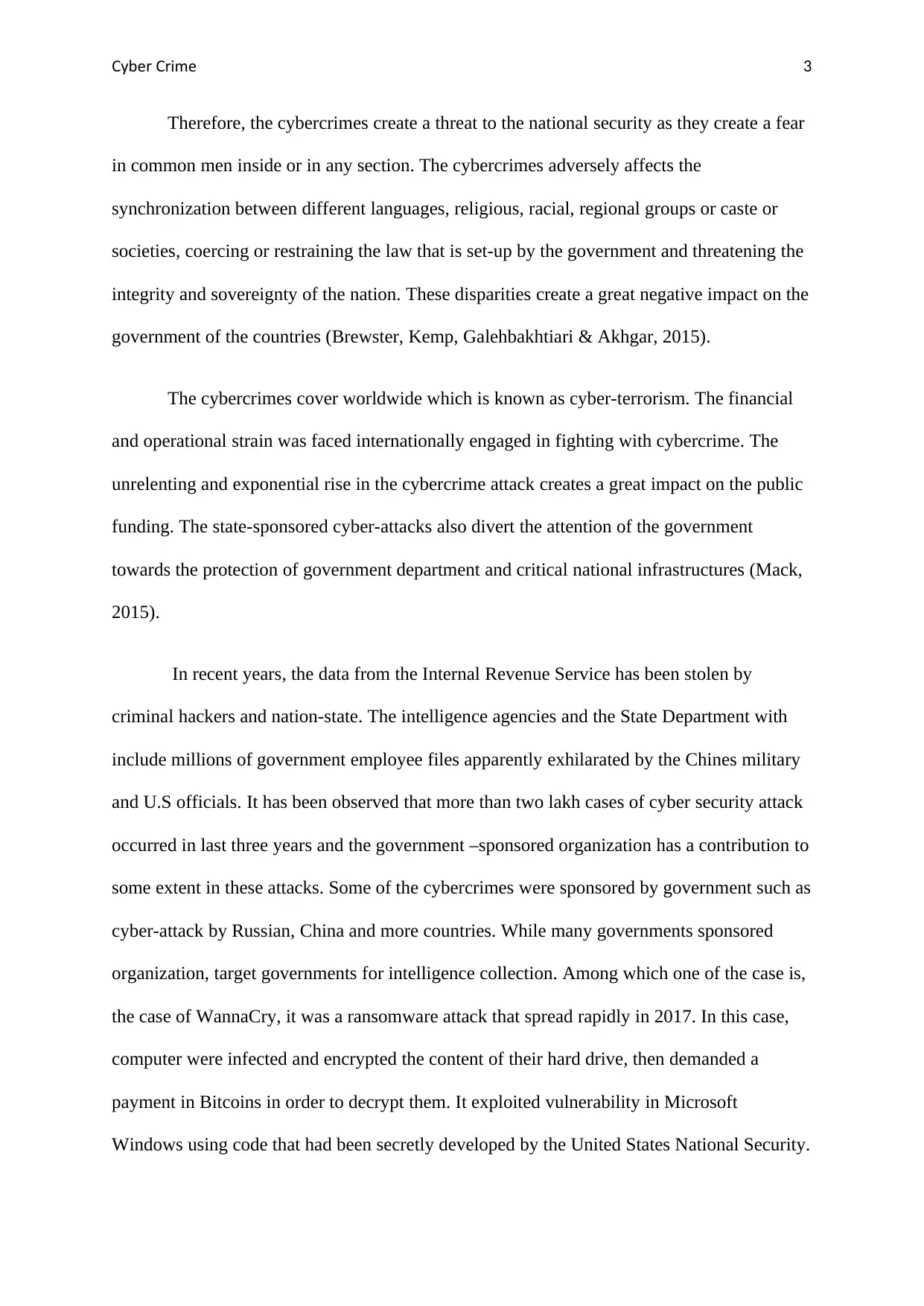
Cyber Crime 3
Therefore, the cybercrimes create a threat to the national security as they create a fear
in common men inside or in any section. The cybercrimes adversely affects the
synchronization between different languages, religious, racial, regional groups or caste or
societies, coercing or restraining the law that is set-up by the government and threatening the
integrity and sovereignty of the nation. These disparities create a great negative impact on the
government of the countries (Brewster, Kemp, Galehbakhtiari & Akhgar, 2015).
The cybercrimes cover worldwide which is known as cyber-terrorism. The financial
and operational strain was faced internationally engaged in fighting with cybercrime. The
unrelenting and exponential rise in the cybercrime attack creates a great impact on the public
funding. The state-sponsored cyber-attacks also divert the attention of the government
towards the protection of government department and critical national infrastructures (Mack,
2015).
In recent years, the data from the Internal Revenue Service has been stolen by
criminal hackers and nation-state. The intelligence agencies and the State Department with
include millions of government employee files apparently exhilarated by the Chines military
and U.S officials. It has been observed that more than two lakh cases of cyber security attack
occurred in last three years and the government –sponsored organization has a contribution to
some extent in these attacks. Some of the cybercrimes were sponsored by government such as
cyber-attack by Russian, China and more countries. While many governments sponsored
organization, target governments for intelligence collection. Among which one of the case is,
the case of WannaCry, it was a ransomware attack that spread rapidly in 2017. In this case,
computer were infected and encrypted the content of their hard drive, then demanded a
payment in Bitcoins in order to decrypt them. It exploited vulnerability in Microsoft
Windows using code that had been secretly developed by the United States National Security.
Therefore, the cybercrimes create a threat to the national security as they create a fear
in common men inside or in any section. The cybercrimes adversely affects the
synchronization between different languages, religious, racial, regional groups or caste or
societies, coercing or restraining the law that is set-up by the government and threatening the
integrity and sovereignty of the nation. These disparities create a great negative impact on the
government of the countries (Brewster, Kemp, Galehbakhtiari & Akhgar, 2015).
The cybercrimes cover worldwide which is known as cyber-terrorism. The financial
and operational strain was faced internationally engaged in fighting with cybercrime. The
unrelenting and exponential rise in the cybercrime attack creates a great impact on the public
funding. The state-sponsored cyber-attacks also divert the attention of the government
towards the protection of government department and critical national infrastructures (Mack,
2015).
In recent years, the data from the Internal Revenue Service has been stolen by
criminal hackers and nation-state. The intelligence agencies and the State Department with
include millions of government employee files apparently exhilarated by the Chines military
and U.S officials. It has been observed that more than two lakh cases of cyber security attack
occurred in last three years and the government –sponsored organization has a contribution to
some extent in these attacks. Some of the cybercrimes were sponsored by government such as
cyber-attack by Russian, China and more countries. While many governments sponsored
organization, target governments for intelligence collection. Among which one of the case is,
the case of WannaCry, it was a ransomware attack that spread rapidly in 2017. In this case,
computer were infected and encrypted the content of their hard drive, then demanded a
payment in Bitcoins in order to decrypt them. It exploited vulnerability in Microsoft
Windows using code that had been secretly developed by the United States National Security.
Paraphrase This Document
Need a fresh take? Get an instant paraphrase of this document with our AI Paraphraser
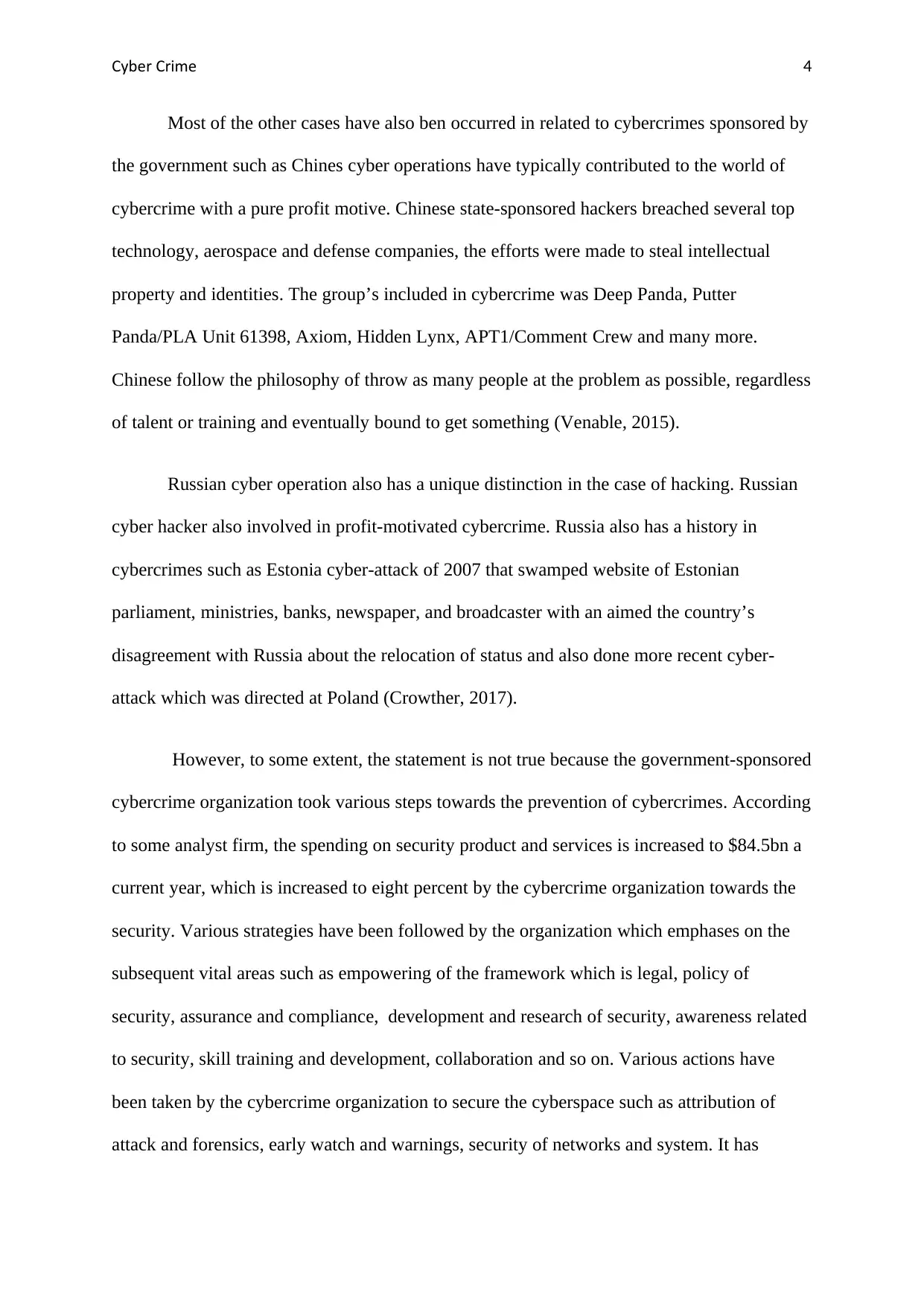
Cyber Crime 4
Most of the other cases have also ben occurred in related to cybercrimes sponsored by
the government such as Chines cyber operations have typically contributed to the world of
cybercrime with a pure profit motive. Chinese state-sponsored hackers breached several top
technology, aerospace and defense companies, the efforts were made to steal intellectual
property and identities. The group’s included in cybercrime was Deep Panda, Putter
Panda/PLA Unit 61398, Axiom, Hidden Lynx, APT1/Comment Crew and many more.
Chinese follow the philosophy of throw as many people at the problem as possible, regardless
of talent or training and eventually bound to get something (Venable, 2015).
Russian cyber operation also has a unique distinction in the case of hacking. Russian
cyber hacker also involved in profit-motivated cybercrime. Russia also has a history in
cybercrimes such as Estonia cyber-attack of 2007 that swamped website of Estonian
parliament, ministries, banks, newspaper, and broadcaster with an aimed the country’s
disagreement with Russia about the relocation of status and also done more recent cyber-
attack which was directed at Poland (Crowther, 2017).
However, to some extent, the statement is not true because the government-sponsored
cybercrime organization took various steps towards the prevention of cybercrimes. According
to some analyst firm, the spending on security product and services is increased to $84.5bn a
current year, which is increased to eight percent by the cybercrime organization towards the
security. Various strategies have been followed by the organization which emphases on the
subsequent vital areas such as empowering of the framework which is legal, policy of
security, assurance and compliance, development and research of security, awareness related
to security, skill training and development, collaboration and so on. Various actions have
been taken by the cybercrime organization to secure the cyberspace such as attribution of
attack and forensics, early watch and warnings, security of networks and system. It has
Most of the other cases have also ben occurred in related to cybercrimes sponsored by
the government such as Chines cyber operations have typically contributed to the world of
cybercrime with a pure profit motive. Chinese state-sponsored hackers breached several top
technology, aerospace and defense companies, the efforts were made to steal intellectual
property and identities. The group’s included in cybercrime was Deep Panda, Putter
Panda/PLA Unit 61398, Axiom, Hidden Lynx, APT1/Comment Crew and many more.
Chinese follow the philosophy of throw as many people at the problem as possible, regardless
of talent or training and eventually bound to get something (Venable, 2015).
Russian cyber operation also has a unique distinction in the case of hacking. Russian
cyber hacker also involved in profit-motivated cybercrime. Russia also has a history in
cybercrimes such as Estonia cyber-attack of 2007 that swamped website of Estonian
parliament, ministries, banks, newspaper, and broadcaster with an aimed the country’s
disagreement with Russia about the relocation of status and also done more recent cyber-
attack which was directed at Poland (Crowther, 2017).
However, to some extent, the statement is not true because the government-sponsored
cybercrime organization took various steps towards the prevention of cybercrimes. According
to some analyst firm, the spending on security product and services is increased to $84.5bn a
current year, which is increased to eight percent by the cybercrime organization towards the
security. Various strategies have been followed by the organization which emphases on the
subsequent vital areas such as empowering of the framework which is legal, policy of
security, assurance and compliance, development and research of security, awareness related
to security, skill training and development, collaboration and so on. Various actions have
been taken by the cybercrime organization to secure the cyberspace such as attribution of
attack and forensics, early watch and warnings, security of networks and system. It has
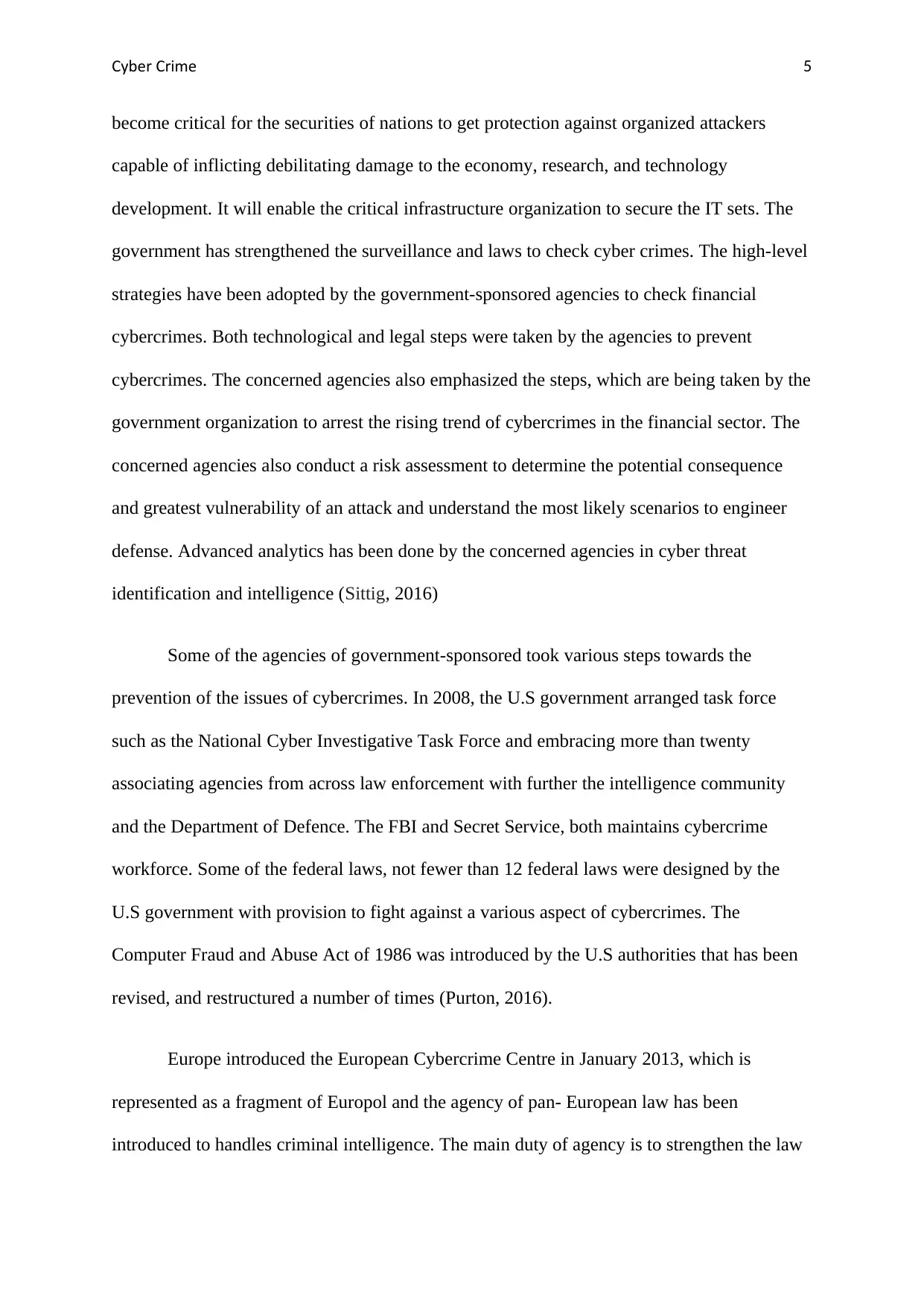
Cyber Crime 5
become critical for the securities of nations to get protection against organized attackers
capable of inflicting debilitating damage to the economy, research, and technology
development. It will enable the critical infrastructure organization to secure the IT sets. The
government has strengthened the surveillance and laws to check cyber crimes. The high-level
strategies have been adopted by the government-sponsored agencies to check financial
cybercrimes. Both technological and legal steps were taken by the agencies to prevent
cybercrimes. The concerned agencies also emphasized the steps, which are being taken by the
government organization to arrest the rising trend of cybercrimes in the financial sector. The
concerned agencies also conduct a risk assessment to determine the potential consequence
and greatest vulnerability of an attack and understand the most likely scenarios to engineer
defense. Advanced analytics has been done by the concerned agencies in cyber threat
identification and intelligence (Sittig, 2016)
Some of the agencies of government-sponsored took various steps towards the
prevention of the issues of cybercrimes. In 2008, the U.S government arranged task force
such as the National Cyber Investigative Task Force and embracing more than twenty
associating agencies from across law enforcement with further the intelligence community
and the Department of Defence. The FBI and Secret Service, both maintains cybercrime
workforce. Some of the federal laws, not fewer than 12 federal laws were designed by the
U.S government with provision to fight against a various aspect of cybercrimes. The
Computer Fraud and Abuse Act of 1986 was introduced by the U.S authorities that has been
revised, and restructured a number of times (Purton, 2016).
Europe introduced the European Cybercrime Centre in January 2013, which is
represented as a fragment of Europol and the agency of pan- European law has been
introduced to handles criminal intelligence. The main duty of agency is to strengthen the law
become critical for the securities of nations to get protection against organized attackers
capable of inflicting debilitating damage to the economy, research, and technology
development. It will enable the critical infrastructure organization to secure the IT sets. The
government has strengthened the surveillance and laws to check cyber crimes. The high-level
strategies have been adopted by the government-sponsored agencies to check financial
cybercrimes. Both technological and legal steps were taken by the agencies to prevent
cybercrimes. The concerned agencies also emphasized the steps, which are being taken by the
government organization to arrest the rising trend of cybercrimes in the financial sector. The
concerned agencies also conduct a risk assessment to determine the potential consequence
and greatest vulnerability of an attack and understand the most likely scenarios to engineer
defense. Advanced analytics has been done by the concerned agencies in cyber threat
identification and intelligence (Sittig, 2016)
Some of the agencies of government-sponsored took various steps towards the
prevention of the issues of cybercrimes. In 2008, the U.S government arranged task force
such as the National Cyber Investigative Task Force and embracing more than twenty
associating agencies from across law enforcement with further the intelligence community
and the Department of Defence. The FBI and Secret Service, both maintains cybercrime
workforce. Some of the federal laws, not fewer than 12 federal laws were designed by the
U.S government with provision to fight against a various aspect of cybercrimes. The
Computer Fraud and Abuse Act of 1986 was introduced by the U.S authorities that has been
revised, and restructured a number of times (Purton, 2016).
Europe introduced the European Cybercrime Centre in January 2013, which is
represented as a fragment of Europol and the agency of pan- European law has been
introduced to handles criminal intelligence. The main duty of agency is to strengthen the law
⊘ This is a preview!⊘
Do you want full access?
Subscribe today to unlock all pages.

Trusted by 1+ million students worldwide
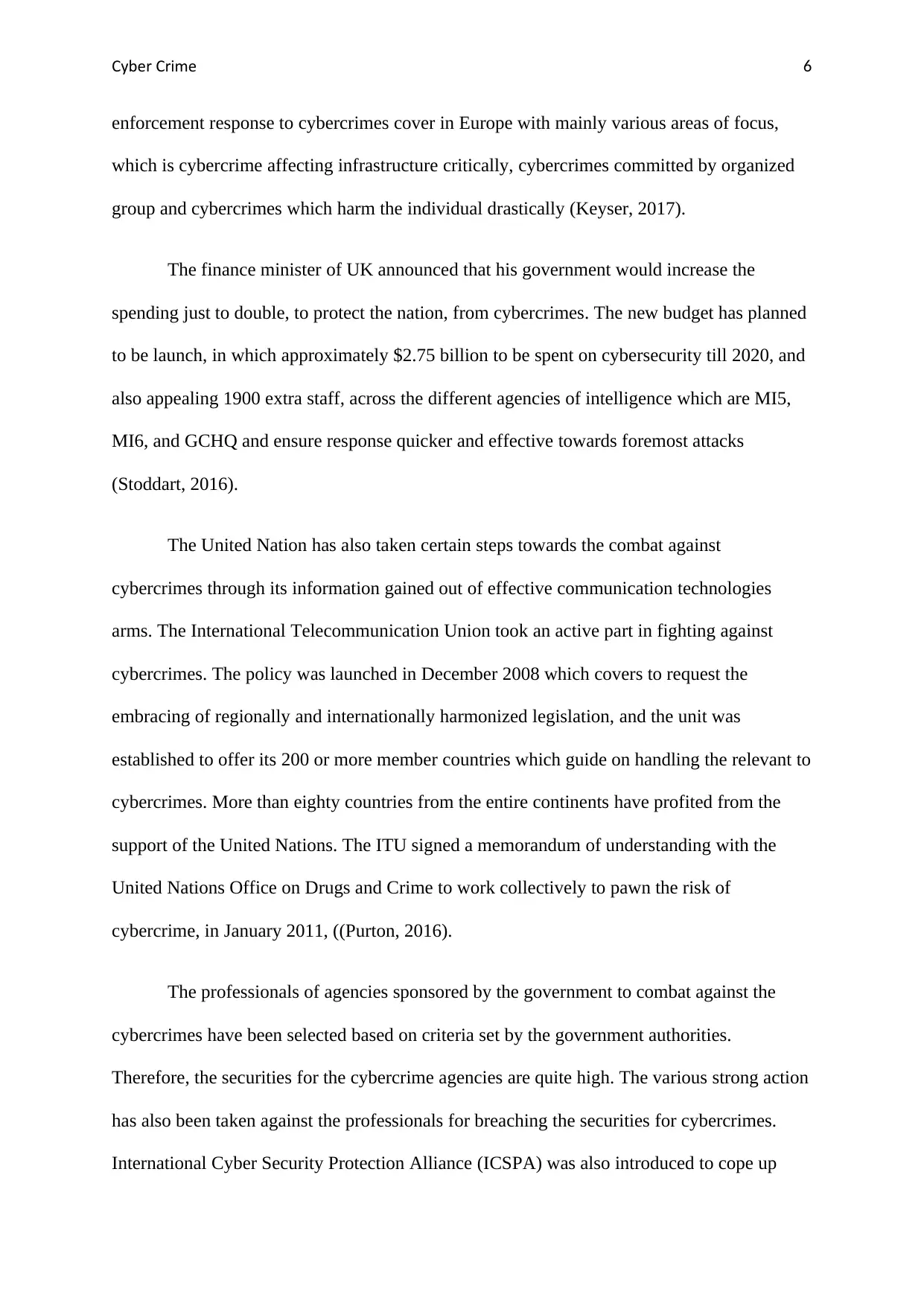
Cyber Crime 6
enforcement response to cybercrimes cover in Europe with mainly various areas of focus,
which is cybercrime affecting infrastructure critically, cybercrimes committed by organized
group and cybercrimes which harm the individual drastically (Keyser, 2017).
The finance minister of UK announced that his government would increase the
spending just to double, to protect the nation, from cybercrimes. The new budget has planned
to be launch, in which approximately $2.75 billion to be spent on cybersecurity till 2020, and
also appealing 1900 extra staff, across the different agencies of intelligence which are MI5,
MI6, and GCHQ and ensure response quicker and effective towards foremost attacks
(Stoddart, 2016).
The United Nation has also taken certain steps towards the combat against
cybercrimes through its information gained out of effective communication technologies
arms. The International Telecommunication Union took an active part in fighting against
cybercrimes. The policy was launched in December 2008 which covers to request the
embracing of regionally and internationally harmonized legislation, and the unit was
established to offer its 200 or more member countries which guide on handling the relevant to
cybercrimes. More than eighty countries from the entire continents have profited from the
support of the United Nations. The ITU signed a memorandum of understanding with the
United Nations Office on Drugs and Crime to work collectively to pawn the risk of
cybercrime, in January 2011, ((Purton, 2016).
The professionals of agencies sponsored by the government to combat against the
cybercrimes have been selected based on criteria set by the government authorities.
Therefore, the securities for the cybercrime agencies are quite high. The various strong action
has also been taken against the professionals for breaching the securities for cybercrimes.
International Cyber Security Protection Alliance (ICSPA) was also introduced to cope up
enforcement response to cybercrimes cover in Europe with mainly various areas of focus,
which is cybercrime affecting infrastructure critically, cybercrimes committed by organized
group and cybercrimes which harm the individual drastically (Keyser, 2017).
The finance minister of UK announced that his government would increase the
spending just to double, to protect the nation, from cybercrimes. The new budget has planned
to be launch, in which approximately $2.75 billion to be spent on cybersecurity till 2020, and
also appealing 1900 extra staff, across the different agencies of intelligence which are MI5,
MI6, and GCHQ and ensure response quicker and effective towards foremost attacks
(Stoddart, 2016).
The United Nation has also taken certain steps towards the combat against
cybercrimes through its information gained out of effective communication technologies
arms. The International Telecommunication Union took an active part in fighting against
cybercrimes. The policy was launched in December 2008 which covers to request the
embracing of regionally and internationally harmonized legislation, and the unit was
established to offer its 200 or more member countries which guide on handling the relevant to
cybercrimes. More than eighty countries from the entire continents have profited from the
support of the United Nations. The ITU signed a memorandum of understanding with the
United Nations Office on Drugs and Crime to work collectively to pawn the risk of
cybercrime, in January 2011, ((Purton, 2016).
The professionals of agencies sponsored by the government to combat against the
cybercrimes have been selected based on criteria set by the government authorities.
Therefore, the securities for the cybercrime agencies are quite high. The various strong action
has also been taken against the professionals for breaching the securities for cybercrimes.
International Cyber Security Protection Alliance (ICSPA) was also introduced to cope up
Paraphrase This Document
Need a fresh take? Get an instant paraphrase of this document with our AI Paraphraser
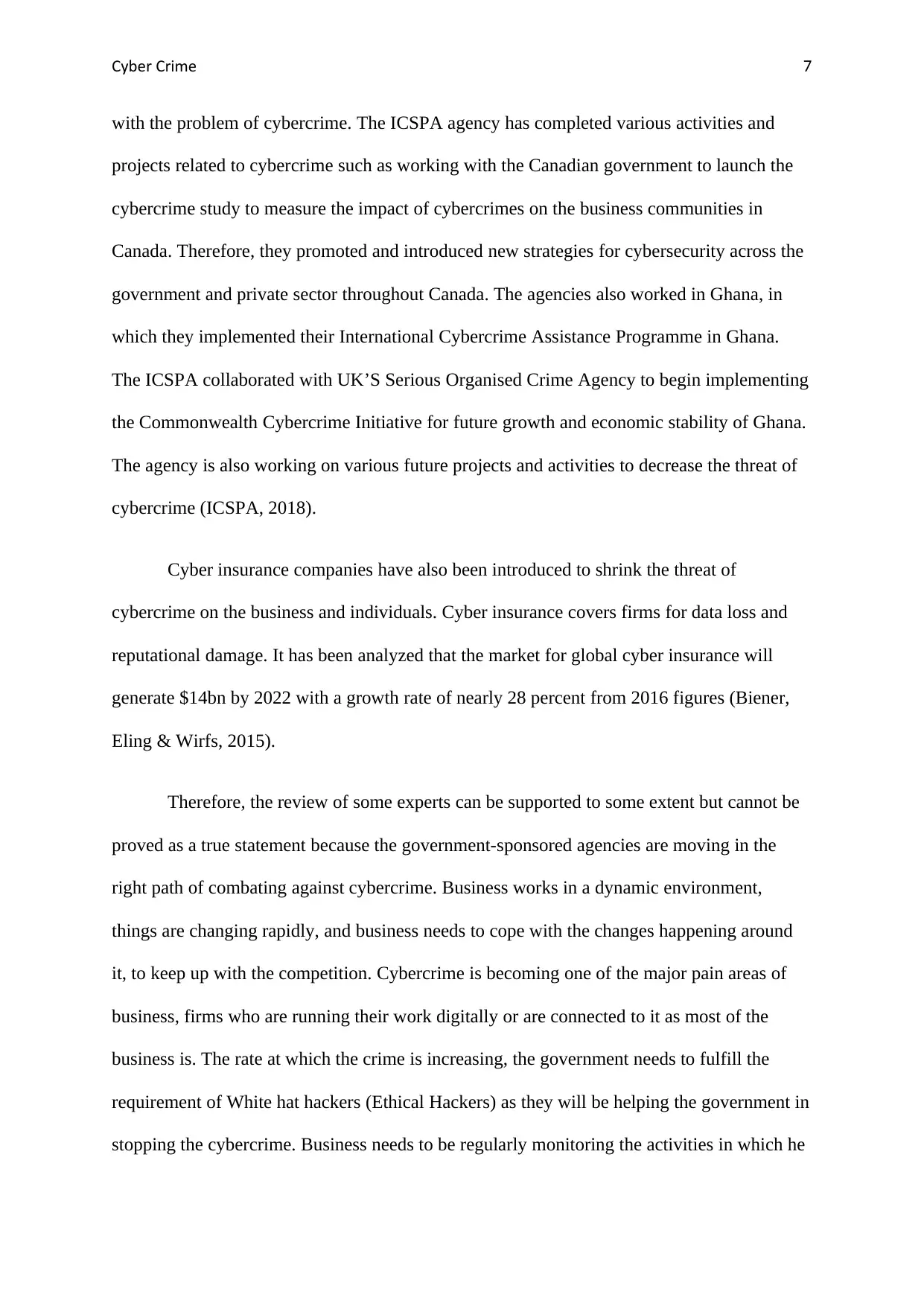
Cyber Crime 7
with the problem of cybercrime. The ICSPA agency has completed various activities and
projects related to cybercrime such as working with the Canadian government to launch the
cybercrime study to measure the impact of cybercrimes on the business communities in
Canada. Therefore, they promoted and introduced new strategies for cybersecurity across the
government and private sector throughout Canada. The agencies also worked in Ghana, in
which they implemented their International Cybercrime Assistance Programme in Ghana.
The ICSPA collaborated with UK’S Serious Organised Crime Agency to begin implementing
the Commonwealth Cybercrime Initiative for future growth and economic stability of Ghana.
The agency is also working on various future projects and activities to decrease the threat of
cybercrime (ICSPA, 2018).
Cyber insurance companies have also been introduced to shrink the threat of
cybercrime on the business and individuals. Cyber insurance covers firms for data loss and
reputational damage. It has been analyzed that the market for global cyber insurance will
generate $14bn by 2022 with a growth rate of nearly 28 percent from 2016 figures (Biener,
Eling & Wirfs, 2015).
Therefore, the review of some experts can be supported to some extent but cannot be
proved as a true statement because the government-sponsored agencies are moving in the
right path of combating against cybercrime. Business works in a dynamic environment,
things are changing rapidly, and business needs to cope with the changes happening around
it, to keep up with the competition. Cybercrime is becoming one of the major pain areas of
business, firms who are running their work digitally or are connected to it as most of the
business is. The rate at which the crime is increasing, the government needs to fulfill the
requirement of White hat hackers (Ethical Hackers) as they will be helping the government in
stopping the cybercrime. Business needs to be regularly monitoring the activities in which he
with the problem of cybercrime. The ICSPA agency has completed various activities and
projects related to cybercrime such as working with the Canadian government to launch the
cybercrime study to measure the impact of cybercrimes on the business communities in
Canada. Therefore, they promoted and introduced new strategies for cybersecurity across the
government and private sector throughout Canada. The agencies also worked in Ghana, in
which they implemented their International Cybercrime Assistance Programme in Ghana.
The ICSPA collaborated with UK’S Serious Organised Crime Agency to begin implementing
the Commonwealth Cybercrime Initiative for future growth and economic stability of Ghana.
The agency is also working on various future projects and activities to decrease the threat of
cybercrime (ICSPA, 2018).
Cyber insurance companies have also been introduced to shrink the threat of
cybercrime on the business and individuals. Cyber insurance covers firms for data loss and
reputational damage. It has been analyzed that the market for global cyber insurance will
generate $14bn by 2022 with a growth rate of nearly 28 percent from 2016 figures (Biener,
Eling & Wirfs, 2015).
Therefore, the review of some experts can be supported to some extent but cannot be
proved as a true statement because the government-sponsored agencies are moving in the
right path of combating against cybercrime. Business works in a dynamic environment,
things are changing rapidly, and business needs to cope with the changes happening around
it, to keep up with the competition. Cybercrime is becoming one of the major pain areas of
business, firms who are running their work digitally or are connected to it as most of the
business is. The rate at which the crime is increasing, the government needs to fulfill the
requirement of White hat hackers (Ethical Hackers) as they will be helping the government in
stopping the cybercrime. Business needs to be regularly monitoring the activities in which he
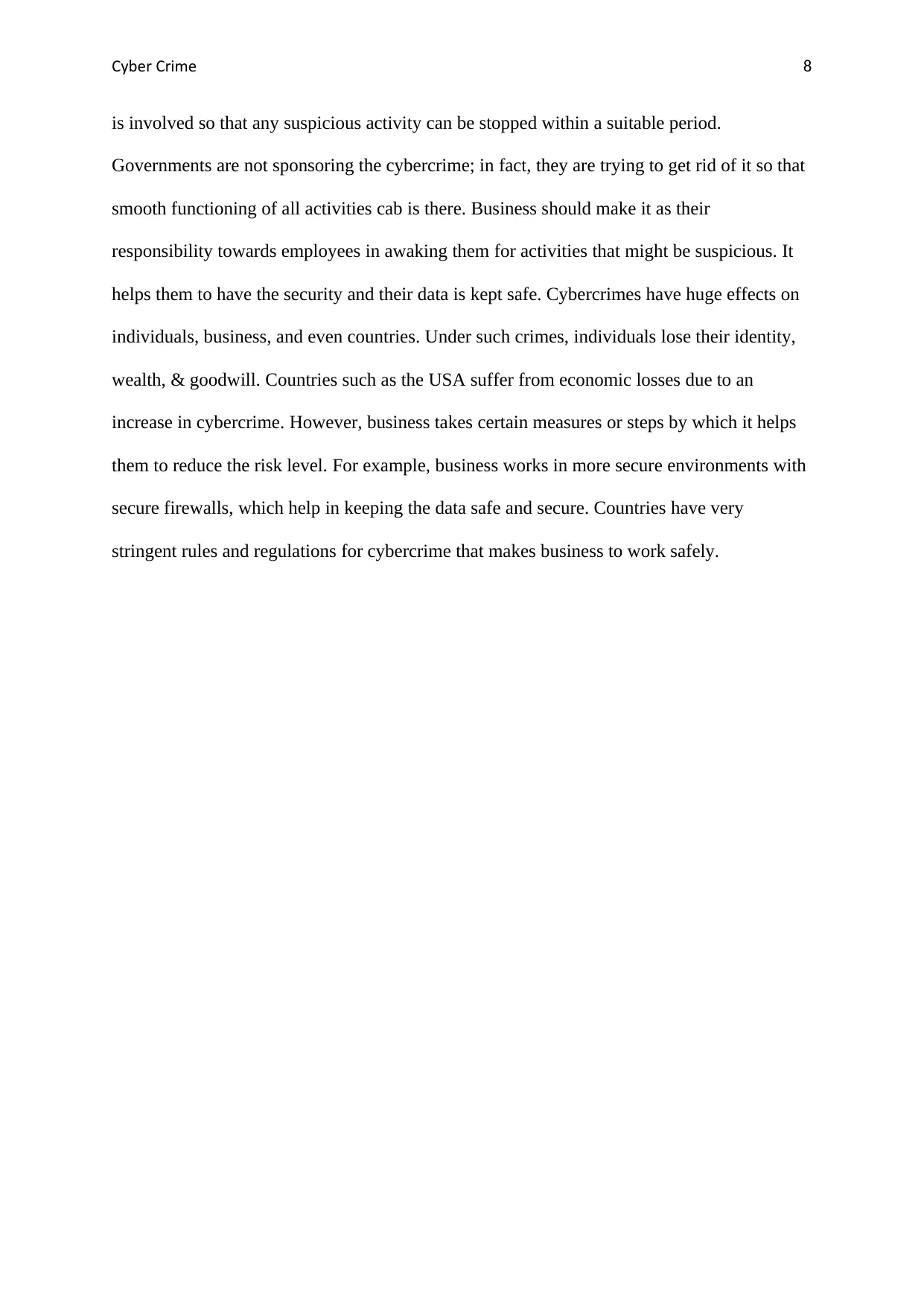
Cyber Crime 8
is involved so that any suspicious activity can be stopped within a suitable period.
Governments are not sponsoring the cybercrime; in fact, they are trying to get rid of it so that
smooth functioning of all activities cab is there. Business should make it as their
responsibility towards employees in awaking them for activities that might be suspicious. It
helps them to have the security and their data is kept safe. Cybercrimes have huge effects on
individuals, business, and even countries. Under such crimes, individuals lose their identity,
wealth, & goodwill. Countries such as the USA suffer from economic losses due to an
increase in cybercrime. However, business takes certain measures or steps by which it helps
them to reduce the risk level. For example, business works in more secure environments with
secure firewalls, which help in keeping the data safe and secure. Countries have very
stringent rules and regulations for cybercrime that makes business to work safely.
is involved so that any suspicious activity can be stopped within a suitable period.
Governments are not sponsoring the cybercrime; in fact, they are trying to get rid of it so that
smooth functioning of all activities cab is there. Business should make it as their
responsibility towards employees in awaking them for activities that might be suspicious. It
helps them to have the security and their data is kept safe. Cybercrimes have huge effects on
individuals, business, and even countries. Under such crimes, individuals lose their identity,
wealth, & goodwill. Countries such as the USA suffer from economic losses due to an
increase in cybercrime. However, business takes certain measures or steps by which it helps
them to reduce the risk level. For example, business works in more secure environments with
secure firewalls, which help in keeping the data safe and secure. Countries have very
stringent rules and regulations for cybercrime that makes business to work safely.
⊘ This is a preview!⊘
Do you want full access?
Subscribe today to unlock all pages.

Trusted by 1+ million students worldwide
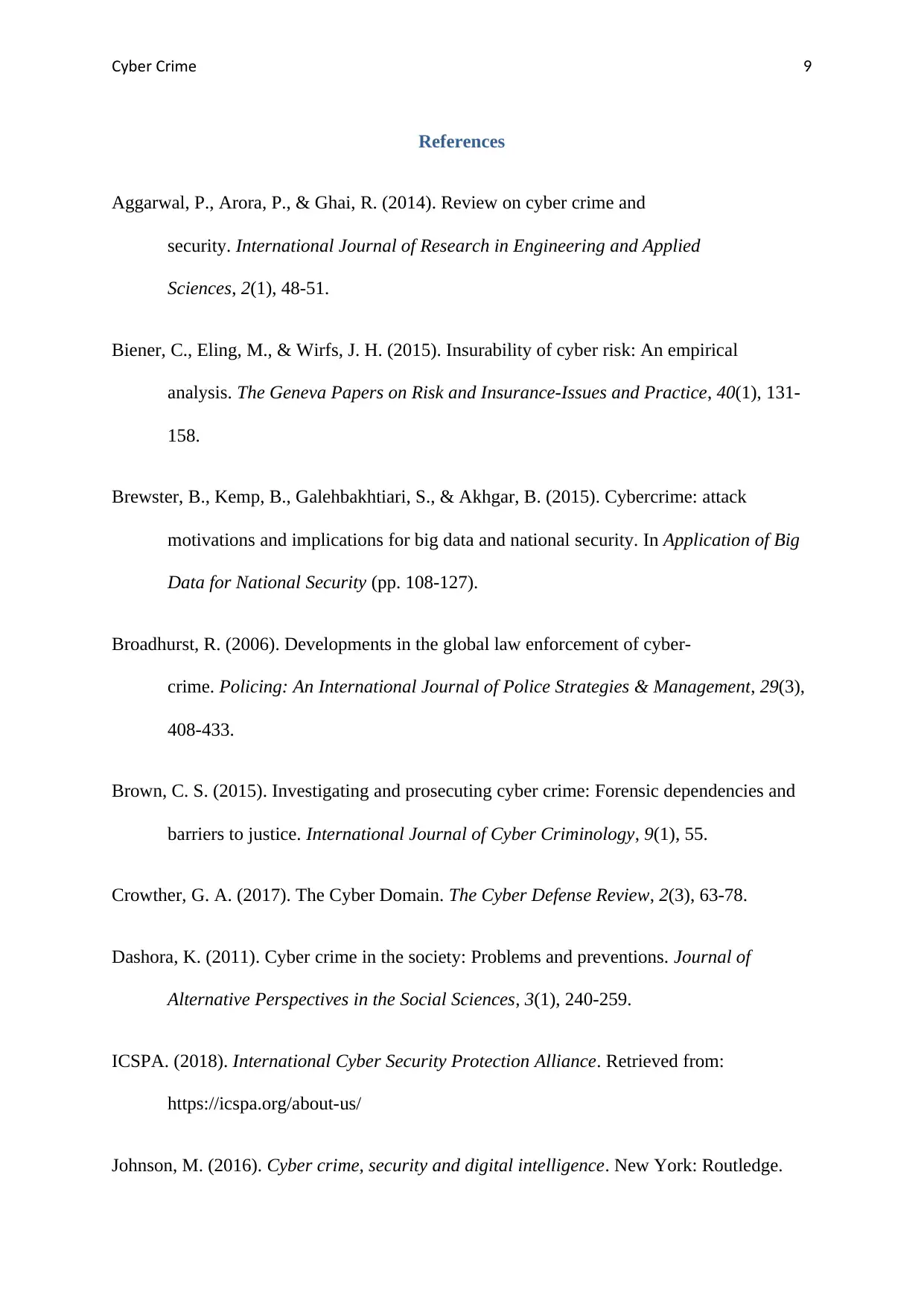
Cyber Crime 9
References
Aggarwal, P., Arora, P., & Ghai, R. (2014). Review on cyber crime and
security. International Journal of Research in Engineering and Applied
Sciences, 2(1), 48-51.
Biener, C., Eling, M., & Wirfs, J. H. (2015). Insurability of cyber risk: An empirical
analysis. The Geneva Papers on Risk and Insurance-Issues and Practice, 40(1), 131-
158.
Brewster, B., Kemp, B., Galehbakhtiari, S., & Akhgar, B. (2015). Cybercrime: attack
motivations and implications for big data and national security. In Application of Big
Data for National Security (pp. 108-127).
Broadhurst, R. (2006). Developments in the global law enforcement of cyber-
crime. Policing: An International Journal of Police Strategies & Management, 29(3),
408-433.
Brown, C. S. (2015). Investigating and prosecuting cyber crime: Forensic dependencies and
barriers to justice. International Journal of Cyber Criminology, 9(1), 55.
Crowther, G. A. (2017). The Cyber Domain. The Cyber Defense Review, 2(3), 63-78.
Dashora, K. (2011). Cyber crime in the society: Problems and preventions. Journal of
Alternative Perspectives in the Social Sciences, 3(1), 240-259.
ICSPA. (2018). International Cyber Security Protection Alliance. Retrieved from:
https://icspa.org/about-us/
Johnson, M. (2016). Cyber crime, security and digital intelligence. New York: Routledge.
References
Aggarwal, P., Arora, P., & Ghai, R. (2014). Review on cyber crime and
security. International Journal of Research in Engineering and Applied
Sciences, 2(1), 48-51.
Biener, C., Eling, M., & Wirfs, J. H. (2015). Insurability of cyber risk: An empirical
analysis. The Geneva Papers on Risk and Insurance-Issues and Practice, 40(1), 131-
158.
Brewster, B., Kemp, B., Galehbakhtiari, S., & Akhgar, B. (2015). Cybercrime: attack
motivations and implications for big data and national security. In Application of Big
Data for National Security (pp. 108-127).
Broadhurst, R. (2006). Developments in the global law enforcement of cyber-
crime. Policing: An International Journal of Police Strategies & Management, 29(3),
408-433.
Brown, C. S. (2015). Investigating and prosecuting cyber crime: Forensic dependencies and
barriers to justice. International Journal of Cyber Criminology, 9(1), 55.
Crowther, G. A. (2017). The Cyber Domain. The Cyber Defense Review, 2(3), 63-78.
Dashora, K. (2011). Cyber crime in the society: Problems and preventions. Journal of
Alternative Perspectives in the Social Sciences, 3(1), 240-259.
ICSPA. (2018). International Cyber Security Protection Alliance. Retrieved from:
https://icspa.org/about-us/
Johnson, M. (2016). Cyber crime, security and digital intelligence. New York: Routledge.
Paraphrase This Document
Need a fresh take? Get an instant paraphrase of this document with our AI Paraphraser
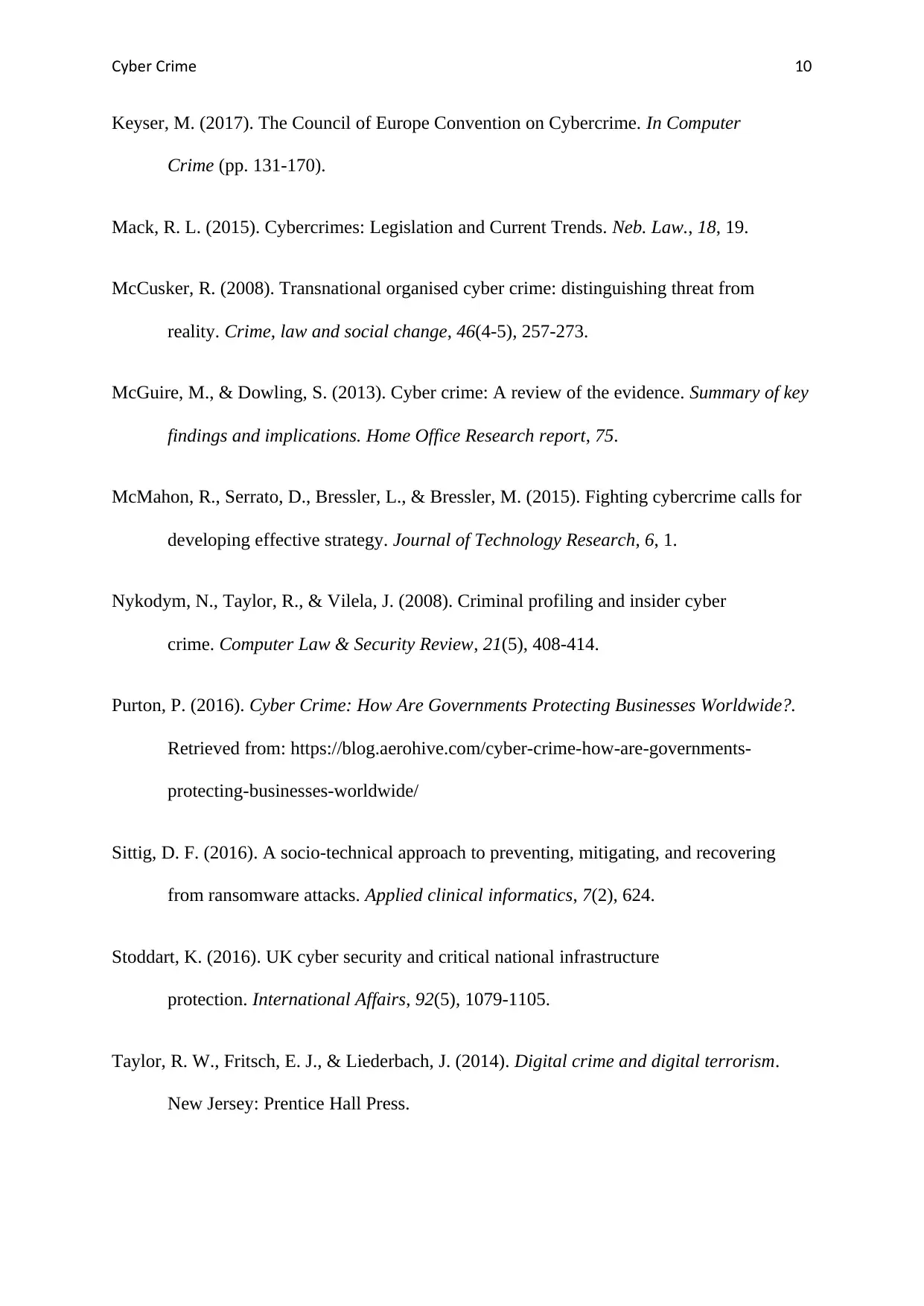
Cyber Crime 10
Keyser, M. (2017). The Council of Europe Convention on Cybercrime. In Computer
Crime (pp. 131-170).
Mack, R. L. (2015). Cybercrimes: Legislation and Current Trends. Neb. Law., 18, 19.
McCusker, R. (2008). Transnational organised cyber crime: distinguishing threat from
reality. Crime, law and social change, 46(4-5), 257-273.
McGuire, M., & Dowling, S. (2013). Cyber crime: A review of the evidence. Summary of key
findings and implications. Home Office Research report, 75.
McMahon, R., Serrato, D., Bressler, L., & Bressler, M. (2015). Fighting cybercrime calls for
developing effective strategy. Journal of Technology Research, 6, 1.
Nykodym, N., Taylor, R., & Vilela, J. (2008). Criminal profiling and insider cyber
crime. Computer Law & Security Review, 21(5), 408-414.
Purton, P. (2016). Cyber Crime: How Are Governments Protecting Businesses Worldwide?.
Retrieved from: https://blog.aerohive.com/cyber-crime-how-are-governments-
protecting-businesses-worldwide/
Sittig, D. F. (2016). A socio-technical approach to preventing, mitigating, and recovering
from ransomware attacks. Applied clinical informatics, 7(2), 624.
Stoddart, K. (2016). UK cyber security and critical national infrastructure
protection. International Affairs, 92(5), 1079-1105.
Taylor, R. W., Fritsch, E. J., & Liederbach, J. (2014). Digital crime and digital terrorism.
New Jersey: Prentice Hall Press.
Keyser, M. (2017). The Council of Europe Convention on Cybercrime. In Computer
Crime (pp. 131-170).
Mack, R. L. (2015). Cybercrimes: Legislation and Current Trends. Neb. Law., 18, 19.
McCusker, R. (2008). Transnational organised cyber crime: distinguishing threat from
reality. Crime, law and social change, 46(4-5), 257-273.
McGuire, M., & Dowling, S. (2013). Cyber crime: A review of the evidence. Summary of key
findings and implications. Home Office Research report, 75.
McMahon, R., Serrato, D., Bressler, L., & Bressler, M. (2015). Fighting cybercrime calls for
developing effective strategy. Journal of Technology Research, 6, 1.
Nykodym, N., Taylor, R., & Vilela, J. (2008). Criminal profiling and insider cyber
crime. Computer Law & Security Review, 21(5), 408-414.
Purton, P. (2016). Cyber Crime: How Are Governments Protecting Businesses Worldwide?.
Retrieved from: https://blog.aerohive.com/cyber-crime-how-are-governments-
protecting-businesses-worldwide/
Sittig, D. F. (2016). A socio-technical approach to preventing, mitigating, and recovering
from ransomware attacks. Applied clinical informatics, 7(2), 624.
Stoddart, K. (2016). UK cyber security and critical national infrastructure
protection. International Affairs, 92(5), 1079-1105.
Taylor, R. W., Fritsch, E. J., & Liederbach, J. (2014). Digital crime and digital terrorism.
New Jersey: Prentice Hall Press.

Cyber Crime 11
Venable, D. (2015). State-Sponsored Cybercrime: A Growing Business Threat. Retrieved
from: https://www.darkreading.com/vulnerabilities---threats/state-sponsored-
cybercrime-a-growing-business-threat/a/d-id/1320555
Venable, D. (2015). State-Sponsored Cybercrime: A Growing Business Threat. Retrieved
from: https://www.darkreading.com/vulnerabilities---threats/state-sponsored-
cybercrime-a-growing-business-threat/a/d-id/1320555
⊘ This is a preview!⊘
Do you want full access?
Subscribe today to unlock all pages.

Trusted by 1+ million students worldwide
1 out of 13
Related Documents
Your All-in-One AI-Powered Toolkit for Academic Success.
+13062052269
info@desklib.com
Available 24*7 on WhatsApp / Email
![[object Object]](/_next/static/media/star-bottom.7253800d.svg)
Unlock your academic potential
Copyright © 2020–2025 A2Z Services. All Rights Reserved. Developed and managed by ZUCOL.




